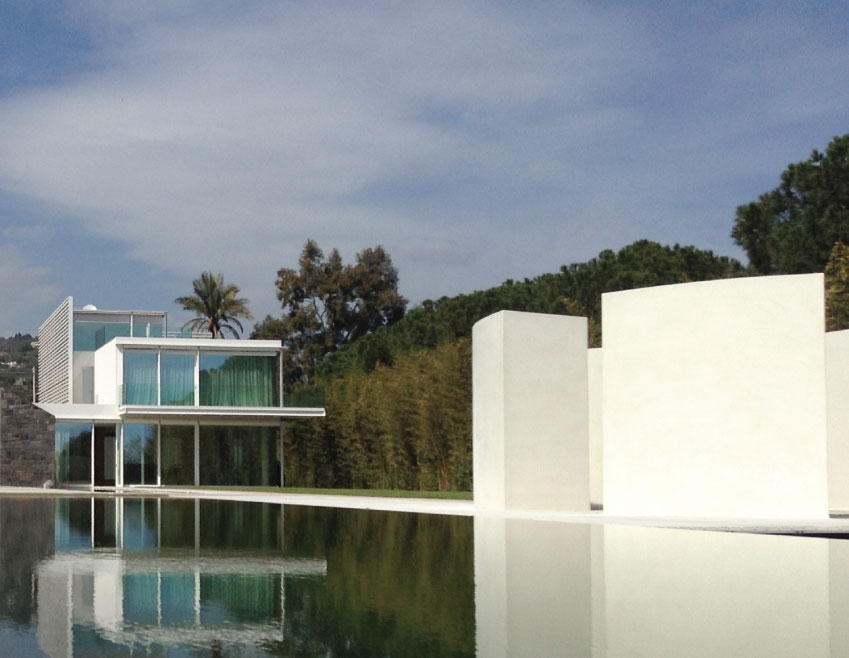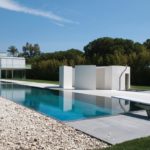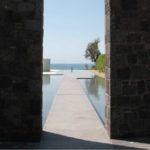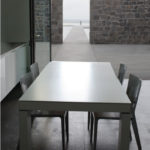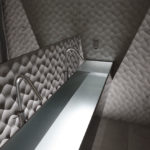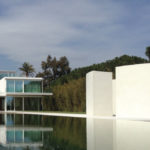Villa A
Villa A is the result of a double intervention: the re-use and restructuring of an existing house and a new extension close to it. The project insists on the dialogue between these two realms as a metaphor of both a traditional and domestic intimacy and a contemporary and clear extroversion.
In fact, if the existing building conserves its closed and massive character, the new one is transparent and luminous. If the former keeps its original pitched-roof geometry and materials (mostly lava stone and wood) the other plays with a minimal geometry and more contemporary materials (steel and glass).
Moreover, in the old structure the roof of many rooms has collapsed and we decided not to restore them to use them as internal patios to provide light and air to the entire complex.
This part is composed by a single level while the new one is composed by three stories above ground and one below. At ground level in the old part there are a double-high kitchen with wooden beams , utility areas, and an independent dependence. In the extension the ground level is entirely occupied by a double level salon/dining completely transparent in all the directions to benefit the views of the garden and the patios all around.
At the first floor of the new part there are three bedrooms each with its own bathroom and at the second floor there is another room with its own bathroom enjoying a solarium and a pensile garden with beautiful views of the sea. The below-ground floor hosts a multifunctional salon and utility areas.
The project is most of all characterized by an intentional environmental care. In the south of Italy the major problem is to protect a building from heath rather from the cold of its tempered winters. So the old complex benefits from the inertia of its thick walls while the façades of the villa employ glasses with adequate solar and exterior curtains. On the roof the pensile garden plays its fundamental cooling role. Finally in the western side of the villa a shading/cooling wall has been conceived to protect the house. More generally sea breezes coming from south slide over the pool creating a cooler microclimate in the site while natural ventilation has been enhanced in the house. The result is an extremely low consumption of energy for air conditioning..
Particular attention has been given to the design of the exterior spaces. The narrow geometry of the site, sloping down towards the sea has been emphasized by the long water mirror that becomes a swimming pool. The dimensions are 58 m in length and 7 m in width. The last 20 m are occupied by the swimming pool while at the center there is a 3 x 3m hydro-massage area. The water mirror has a 10 cm depth and it degrades with a staircase to -1.2 m in the central part of the swimming pool to the -2.50 of the diving pool. The whole starts from the stone wall of the kitchen’s patio and spans to the end of the garden to merge with the sea in front of it. The wall of the patio is cut with a single vertical slot to enhance the landscape from the kitchen and the patio, and from this slot a narrow passage leads to a solarium surrounded by water. Finally, the pool inherits the grey color of the sea beds of the region becoming part of the landscape For this reason it has been awarded the Italian Pool Award 2014.
The interior design of the Villa_A follows the same strategy of the overall project: the interiors are strongly interconnected with the exteriors space and the choice of materials play with the two realms. In the living dining room two materials differentiate the two levels of the ambiance: white natural stone for the area of sofas and a woodwork for the library/staircase area that will accommodate the dining area with a more intimate atmosphere. In the kitchen white is the predominant color to emphasize diffuse light. The dining area is aligned with passage leading to the pool outside the patio in front of the kitchen. The furniture has been chosen for its minimalist simplicity. Below ground there’s a multimedia hall. The back lit ceiling uses the same material of the projection screens. Trapezoidal glass blocks bring light from the external interstice protecting the house from the surrounding terrain. Finally each of the bathroom has been characterized with different materials.

